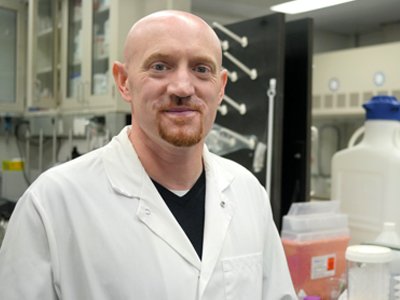Teaming up to Fight Diabetes
Syracuse researcher collaborates with biotech company to research new ways to deliver and/or protect drugs

When it comes to new drug development, two heads can be better than one. To that end, Syracuse chemistry professor Robert Doyle is teaming up with St. Louis based company Xeragenx LLC to create a new treatment for diabetes, for example.
Diabetes, which leads to an elevation in blood sugar levels, is widespread. According to the American Diabetes Association, the disease affects upward of 29.1 million Americans and, as of 2010, was the seventh leading cause of death in America.
The drug Doyle is working with aims to treat two aspects of type 2 diabetes, which is strongly linked to being overweight. The new drug will both regulate blood sugar levels and reduce appetite to support weight loss. Weight loss is particularly important for overweight individuals with type 2 diabetes because of the tie between increased weight and a reduced ability to regulate blood sugar.
Engineering a drug that treats diabetes is just one challenge to pharmaceutical development. The drug also has to get to the site in the body where it’s needed. Diabetes drugs need to make their way to a target, which in some cases is the pancreas, the organ responsible for regulating blood sugar levels. The pathway from swallowing a pill to the drug arriving at the pancreas requires multiple steps. The drug must resist being broken down in the stomach, be transferred through the wall of the digestive tract and into the blood stream, and ultimately make it to its final destination—the pancreas.
Pharmaceutical drugs aren’t the only molecules that need to traverse a hostile digestive tract to get where they need to go. Take vitamin B12, a critical nutrient for production of red blood cells. With the help of a stomach-produced protein called Intrinsic Factor, B12 makes its way from the stomach to the bloodstream to prevent anemia.
Doyle’s research aims to take advantage of the unique B12 absorption pathway for getting into the bloodstream without being degraded for use in drug delivery. Many proteins are added to the vitamin after ingestion, which escort B12 from the stomach, down the length of the small intestine and across the intestinal wall into the bloodstream. “The vitamin has a series of proteins that protect and transport it, so we’re exploiting the proteins that do for B12 what we want them to do for a drug,” Doyle explains.

To this end, Doyle is collaborating with Xeragenx, a small biotech company that makes pharmaceutical-grade Intrinsic Factor, one of the shepherding proteins. “Intrinsic Factor is the key that unlocks a unique receptor in the small intestine to facilitate absorption of B12,” explains Xeragenx President Jonathan Bortz. Too little Intrinsic Factor, which can be caused by things like bariatric surgery or drugs that treat acid reflux, and B12 can’t get where it’s going.
What’s more, Doyle and collaborators at SUNY Upstate and Christian-Albrechts-University, in Germany have recently shown that Intrinsic Factor can also protect pharmaceuticals attached to the B12 complex. In their recent Molecular Pharmaceutics paper, the researchers attached a diabetes drug to B12 with or without Intrinsic Factor. These different complexes were then exposed to normally occurring body enzymes that break down proteins like the tested drug. Doyle and team found that attaching both B12 to the drug and subsequently having Intrinsic Factor bind to the B12-drug conjugate formed, increased drug function up to five-fold versus when the drug was introduced to the degrading enzymes on it’s own.
By combining B12 and Intrinsic Factor’s navigational and protective tools, Doyle’s team will make it possible for the previously developed dual-acting diabetes drug to be taken orally instead of through a standard injection. He explains that the approach is to stick the drug directly on B12, complete with Intrinsic Factor, so the protected drug “comes along for the ride.”
“Professor Doyle has become the world’s expert in attaching B12 to certain proteins to determine whether this would make them amenable to oral absorption,” Bortz says.
“Xeragenx’ Intrinsic Factor and Professor Doyle’s B12-conjugate chemistry expertise were just made for each other to collaborate,” Bortz says of the three-year relationship. “Xeragenx is proud to be in its third year of successful sponsored research with Syracuse University in this cutting-edge field that is drawing the attention of some big names in the pharmaceutical industry,” he continues, crediting Xeragenx’ excellent working relationship with both Doyle and the University’s Office of Technology Transfer.
Doyle agrees, “This relationship is a great way to explore the B12 pathway in drug development.”
Doyle’s paper on protecting proteins from enzyme degradation using Intrinsic Factor can be found here.
Featured
Robert Doyle Jack and Laura H. Milton Professor and Dean's Professor of Chemistry
